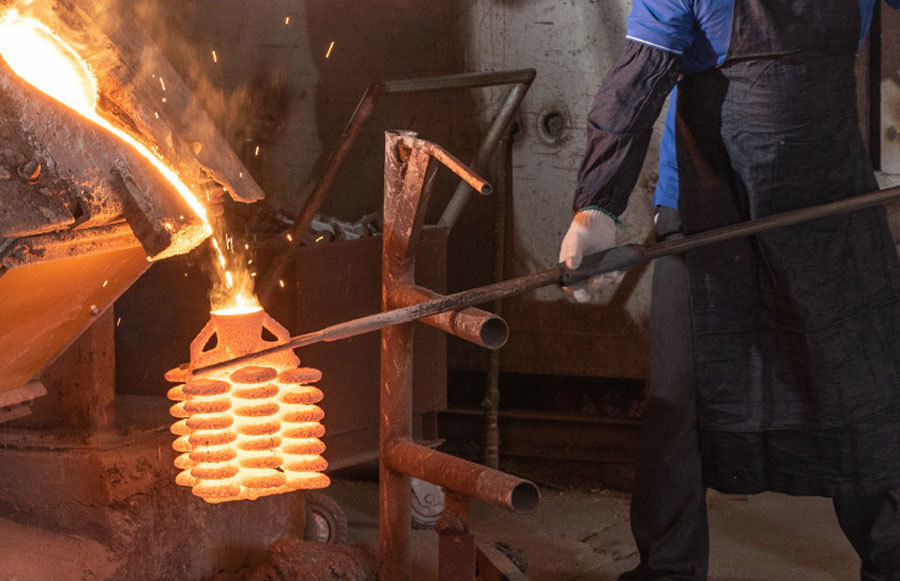History and Development of Investment Casting

Investment casting is also known as lost wax casting. Its products are precise, complex and close to the final shape of the part. It can be used directly without processing or with little processing. Therefore, investment casting is an advanced technology close to the final shape.
The history of investment casting can be traced back to 4000 years ago. The countries of origin were Egypt, China and India, and then spread to other countries in Africa and Europe.
In ancient China, there were many casting moulds, such as the Wu Ding Taizi and bronze wares at the end of the Spring and Autumn Period, the Zhengzhou Yizun Peace Pot during the Warring States Period, the Tongcuojin Boshan Furnace and the Changxing Palace Lantern during the Han Dynasty., And a gilded bronze statue of Amitabha Buddha was made during the Qin and Qin dynasties of the Sui Dynasty. The armillary sphere of the Ming Dynasty, the statue of Emperor Zhenwu of Wudang and the bronze lion of Taihe Gate in the Qing Palace.
cast bronze statue
In West Africa after about the 11th century, casts were cast in large numbers. In the 16th century, the investment casting process was widely used by artists and sculptors. The bronze statue of the Perseus Cepheid and the leader of the Banshee, made by Benvenuto Cellini (Benvenuto Cellini), is one of the most outstanding works.
The earliest written record of lost wax castings in the world is the Eastern Heaven Love Record by Zhao Xihu of the Southern Song Dynasty (1127-1279 AD). Then there were Zailini's 1568 treatise, Song Yingxing's "Tiangong Enlightenment" in the Ming Dynasty, and VaVrinec Krickes's "Cannon, Ball, Chasing Gun, Bell Casting and Preparation Guidance" in the mid-16th century, among others.
At the end of the 19th century, dental castings were used for dental investment casting and combined with centrifugal casting technology to produce dental castings. In the early 20th century, in order to produce thicker dental parts, people began to study the factors that affect the dimensional stability of wax patterns and shells and the solidification and shrinkage properties of certain metals and alloys. In the early 1930 s, the materials used for the investment were adjusted. From 1900 to 1940, there were more than 400 patents in this field. Investment casting technology is also widely used in the jewelry industry.
If traditional alloys are used, aircraft engine parts (such as turbochargers) that work in harsh environments will not be able to meet performance requirements. In the late 1930 s, it was discovered that a drill-based alloy developed in the Austin laboratory for surgical implantation had excellent properties at high temperatures and could be used in turbochargers. However, such alloys are difficult to process, and investment casting has become a processing method for forming such alloys. It rapidly developed industrial technology, entered the aviation and defense industries, and was quickly applied to other industrial fields.
Since investment casting was used in industrial production in the 1940 s, investment casting has been developing at a relatively rapid rate for half a century. According to reports, in 1996, the world investment casting industry (excluding the former Soviet Union) accounted for 50% in North America, 25% in Europe, 20% in Asia, and the remaining 5%. The United States, China and the United States account for 95%, while Europe is the United Kingdom 42%, France 26%, Germany 19%, Italy 7% and the remaining 6%. In the United States, sales of precision casting reached $2.61 billion. In 1970 and 1980, U.S. sales of precision castings were $0.25 billion and $1.1 billion, respectively, 10.4 times that of 1970 and 1970 and 2.37 times that of 1980. Industry is developing rapidly.
Now, investment casting is used in almost all industrial fields except aviation and weapons industries, especially electronics, petroleum, chemical industry, energy, transportation, light industry, textile, pharmaceutical, medical machinery, pumps and valves.
Key words:
Previous Page:
Next page:
Recommend News
Share To




